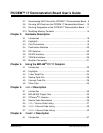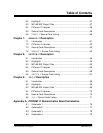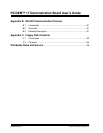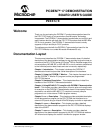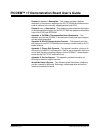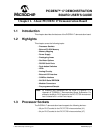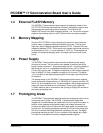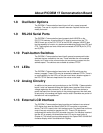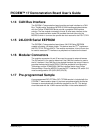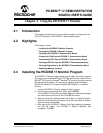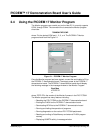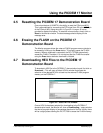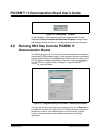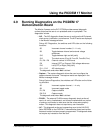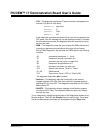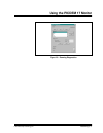
PICDEM™ 17 Demonstration Board User’s Guide
DS39024B-page 6 2001 Microchip Technology Inc.
1.14 CAN Bus Interface
The PICDEM 17 demonstration board provides a simple interface to a CAN
Bus. The Microchip Technology MCP2510 CAN Interface peripheral device
with the Phillips PCA82C250 device provide a complete CAN Interface
solution. The two modular connectors J4 and J5 allow easy interface to the
bus. The canned oscillator socket O2 provides the clock source for the
MCP2510 which in turn can also provide the clock source for the PIC17C7XX.
1.15 24LC01B Serial EEPROM
The PICDEM 17 demonstration board has a 24LC01B Serial EEPROM
capable of holding 128 bytes of data. This device uses the I
2
C
™
interface on
the PIC17C7XX PICmicro MCU. The modular connectors J4 and J5 can also
be used to create an I
2
C interface to a peripheral not located on the board.
1.16 Modular Connectors
The modular connectors J4 and J5 are used to connect to external busses.
The DIP switch S14 is used to determine if the CAN Bus interface is used or
the I
2
C interface. If the CAN Bus is the desired interface, the user will have to
populate the board with the MCP2510 CAN Bus peripheral from Microchip
Technology and the PCA82C250 CAN Bus interface device from Philips
Semiconductor. Since the MCP2510 uses the SPI™ interface, DIP switch S13
must be configured for SPI (SCK,SDO,SDI,CS).
1.17 Pre-programmed Sample
A pre-programmed PIC17C756 or PIC17C756A sample is included with the
PICDEM 17 demonstration board. It has been programmed with the Monitor
firmware to communicate with the Monitor program on the PC. This device
should be used with the 16 MHz canned oscillator in the socket labeled O1.



